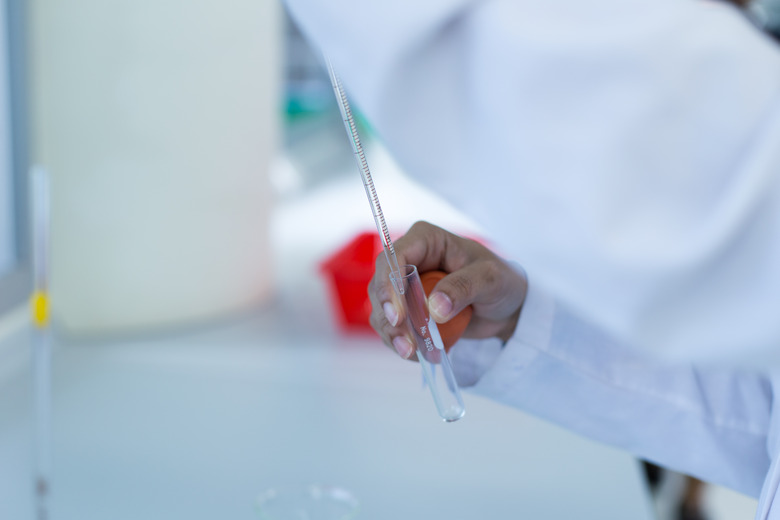The Advantages Of Potentiometric Titration
Many compounds, especially in pharmaceuticals, require high purity. To check for sample (analyte) purity, you must perform titration so that one volume of the solution reacts the same as another solution. You add measured increments of a titrant until the endpoint or equivalence point, until the entire sample has reacted. Potentiometric titration can be categorized as acid-base titration, redox reaction or precipitation titration.
TL;DR (Too Long; Didn't Read)
Potentiometric titration requires measuring the voltage change of a titration across a sample needing purification. It provides an adaptable, relatively affordable and highly accurate method to achieve high purity, essential to many fields, particularly pharmaceuticals.
Methodology of Potentiometric Titration
Methodology of Potentiometric Titration
In titrations, solid samples are weighed and dissolved in a particular solvent with a known volume of a standardized titrant. The burette portion of the instrument (whether pH meter or automatic titrant) houses the titrant and dispenses it into a testing vessel. The titrant flows past a reference electrode before an indicator electrode. Reagent water is added if necessary to cover electrodes.
Potentiometric titration requires measurement by electrodes of voltage change across the sample or analyte. A pair of electrodes or combination electrode is used to determine the endpoint of the titration. The endpoint describes the point at which the entire sample has reacted. At that point, the greatest range of change of potential is reached. Voltage and volume are recorded and graphed. Potential is measured in millivolts. Plotting these values gives a sigmoid curve. The endpoint is reached with there is a rapid change in slope voltage versus volume. The endpoint can be manually located by using concentric arc templates, or microprocessors may be used to choose the endpoint automatically. After the amount of synthesized chemical in a sample is found, its purity and concentration can be determined. Most potentiometric titrations have a lower concentration limit of approximately 10-4 M. Software allows for minimization of any errors.
Benefits for Potentiometric Titrations
Benefits for Potentiometric Titrations
Potentiometric titrations are direct titrations that require no indicator. In some models, however, two electrodes, an indicator and a reference electrode may exist. This kind of titration is far more accurate and precise than manual titration, with high accuracy up to three digits in milliliters.
A number of kinds of potentiometric titrations exist, providing options depending on the need for determining analytes. These include acid-base, redox, precipitation and complexometric.
Potentiometric titrations also work well as automated systems, with greater capacity for sample processing. While more modern methods can be used to determine pH, such as high performance liquid chromatography (HPLC) and capillary electrophoresis (CE), potentiometric titrations offer affordability and simplicity. They come with capability for automation and with calibration software. These qualities ensure the continued usefulness of potentiometric titrations.
Cite This Article
MLA
Hermance, Dianne. "The Advantages Of Potentiometric Titration" sciencing.com, https://www.sciencing.com/advantages-potentiometric-titration-6532902/. 15 May 2018.
APA
Hermance, Dianne. (2018, May 15). The Advantages Of Potentiometric Titration. sciencing.com. Retrieved from https://www.sciencing.com/advantages-potentiometric-titration-6532902/
Chicago
Hermance, Dianne. The Advantages Of Potentiometric Titration last modified March 24, 2022. https://www.sciencing.com/advantages-potentiometric-titration-6532902/
